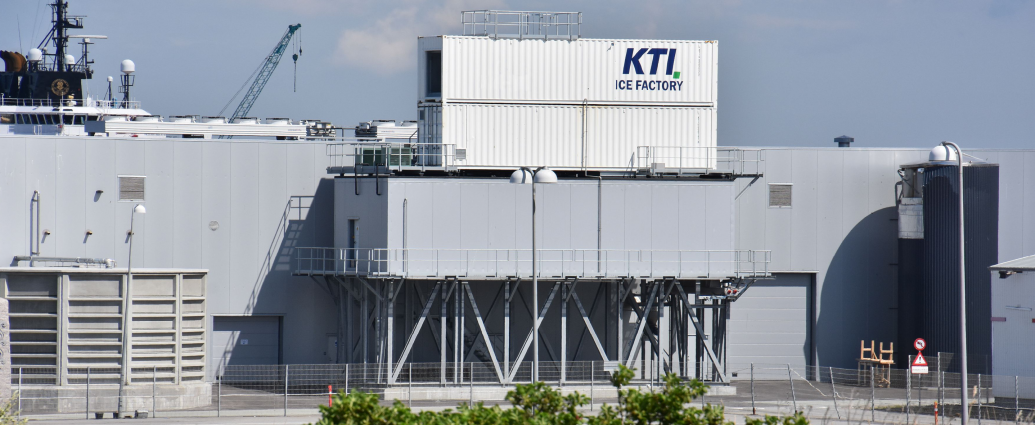In 2018, a fish processor needed machinery to produce and store flake ice for cold fish shipping for a new factory on Denmark’s North Sea coast. Given the planned size of the 90-tonne ice storage at 15 m long, 4 m high and 4.5 m wide, a solution was required that could be installed outside the factory building. At the same time, the food processor had to meet demanding hygienic requirements, meaning that the plant components coming into contact with water and ice would have to be food-safe. The company placed an order with KTI-Plersch Kältetechnik GmbH of Balzheim, Germany, a plant manufacturer with a 30-year track record in this field. The ice plants were installed in containers and set up next to the outside wall of the building so they take up no interior space. Almost all parts coming into contact with ice are of stainless steel, and the design is optimized for thorough cleaning, enabling fully hygienic operation. Furthermore, the use of ammonia and an economizer in ice production, plus integrated water pre-chiller, keep energy use about 10 percent lower than comparable ice plants.
World fish consumption has risen steadily for years, as figures from the World Nutrition Organization FAO show. Currently, 154.2 million tonnes are consumed each year. In order to harvest, process and ship these enormous quantities, well-networked production and supply chains are needed that get fresh fish to consumers quickly and as freshly caught as possible. Proper cooling is essential for keeping fish fresh, and in most cases this involves the use of ice. This is the case at the factory of a big fish processor in northern Denmark. “The 15-metre ice plant was too large for the factory, so it had to be sited outside the building,” reports Michael Walleter, director of Sales and Marketing at KTI-Plersch Kältetechnik GmbH. “At the same time, we needed to carefully plan the 40-metre feed distance from ice production and storage to the four ice dosers that fill the ice into fish shipping crates. Otherwise there can be difficulties in supply, since the dosers can only take about 150 kilos of ice at a time, and every metre of distance reduces the flexibility of supply.”
Another challenge was the design of the machinery itself, since the ice has to be hygienically pristine at all times. That meant leaving as few hard-to-clean corners and gaps as possible. The ice plant produces ice flakes about 1.5 to 2 mm thick, which are liable to clump due to air humidity, and to partial melting and refreezing, so KTI also had to pay attention to keeping the humidity and temperature in the ice storage at a constant low level. Otherwise the ice would not be properly dosable, and would furthermore lose its major advantage over other forms of ice, namely its low volume and high surface area for maximum cooling effect. And last but not least, the energy efficiency of the entire plant had to be as high as possible, since ice making is a very energy-intensive process.
Modular design of the plant with standard containers
“We solved the problem of lack of space inside the building by installing the machinery in standard shipping containers,” explains Walleter. “This approach, which is typical for our refrigeration solutions, made it possible to stack the powerful ice maker, which can turn out 100 tonnes a day, and the associated 90-tonne storage unit with KTI’s proprietary ice rake system, on a steel structure next to the outer wall of the factory. The ice conveyors and distributors under the ceiling inside the building are thus easily accessible. As a result, no inside space is used, and the ice can be sent to the dosers quickly.” Nevertheless, for the remaining ice feed distance, the interaction with ice storage still had to be carefully controlled. “For this we developed an intelligent control system that makes sure there is always enough ice, while preventing it from staying unused in the transportation system for too long,” reports Walleter. “The choice of suitable screw conveyors, which are lubricated exclusively with food-safe grease, and the lack of a hopper ensures that the ice flakes will not clump or get contaminated on the way from storage to the fish shipping containers.”
To meet requirements for the hygienic production and storage of the ice, KTI chose to use stainless steel for almost all of the components coming into contact with the ice. “The construction of a stainless steel tank inside the ice storage was a big challenge,” explains Walleter. “Since there is a moving rake to keep the ice evenly distributed, there couldn’t be any cross-struts. We still needed to provide for the stability and evenness of the walls. Many metal fabricators turned the job down, so we had to make the tank ourselves.” The antibacterial properties of the stainless steel and its imperviousness to cleansers virtually preclude any contamination of the ice, while making cleaning easier. In constructing the system, ground welded seams were used to minimize dead spaces, while components that are difficult to clean, like the drives for the moving rakes, were enclosed in housings. Another feature minimizing the risk of contamination is an automatic lubricant dispenser for the regular lubrication of moving parts with food-safe grease.
Energy efficiency through ammonia, economizer and pre-chiller
Finally, to optimize energy efficiency through the entire process from ice making to storage and delivery, KTI also installed a pre-chiller that cools the supplied fresh water from 18 °C down to 5 °C, before it is frozen in to ice. The pre-chiller refrigeration unit works in the 0 °C range, while the ice is frozen at -25 °C, meaning that the freezing unit requires less energy. This gives substantial savings. “In addition, as a refrigerant for ice production we use ammonia (NH3), which is environmentally unproblematic and available in basically unlimited quantity. In combination with an economizer and the pre-chiller, this improves energy efficiency by about 10 percent over comparable plants,” according to Walleter. “The storage was comprehensively insulated to prevent warming of the air in ice storage by the outside air, which would increase energy consumption.” KTI used its patented Air Channels, which are unique in the industry. These form a kind of insulating layer between the inner and outer walls of the container, through which cold air constantly flows. This holds the temperature inside the storage at a constant -7 °C, preventing gradual warming and thawing of the ice. This technical outfitting of the ice storage ensures that once produced, the ice can be stored with no problems for several days, and then delivered and dispensed.
“Overall, installation of the entire ice supply parallel to the ongoing construction of the factory proceeded rapidly and problem-free, since we had preassembled all of the machinery in-house, eliminating the need to do much of the work on-site,” explains Walleter in conclusion. “Thus, after delivery of the containers to the factory grounds by truck, we just had to put them together and connect the lines and cables. There was almost no interference with the customer’s operations, and installation time was reduced from three or four months to about six weeks.”

